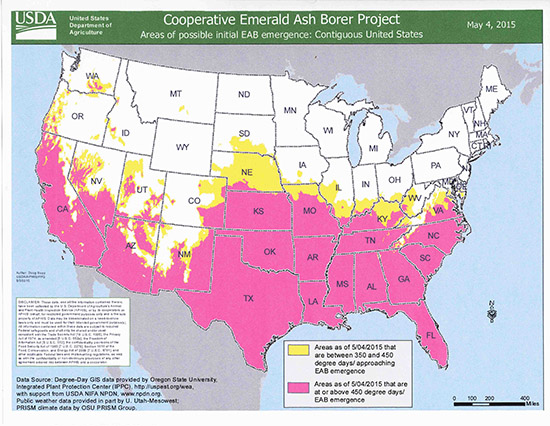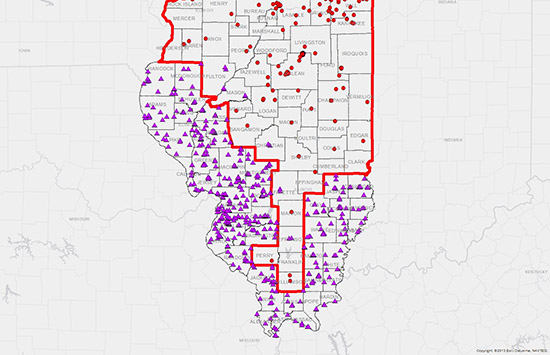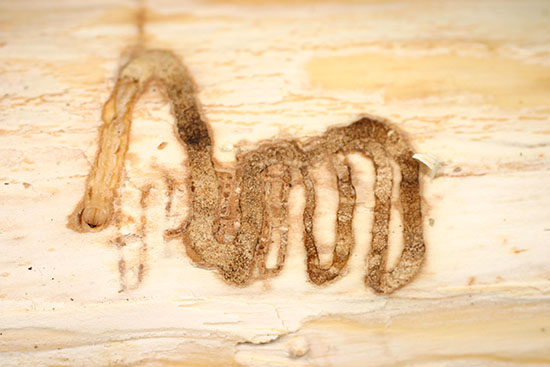Issue 3, May 11, 2015
Emerald Ash Borer
Emerald ash borer should be emerging in southern Illinois this week. It will probably emerge in central Illinois next week, and in northern Illinois in early June. The accompanying map from May 2 shows the 450 degree day base 50 degrees F area of Illinois and surrounding areas at that time. Emerald ash borer adults emerge at 400-500 DD. Referring to the degree day article in this newsletter issue reveals that we have reached that level in southern Illinois. Ash leaf expansion is proceeding on a pace to warrant insecticide application to control this insect.


Emerald ash borer larvae tunnel in the cambium of true ashes, those in the genus Fraxinus, including black, green, white, and blue ash. They do not attack mountain ash or wafer ash, not being in that genus or family. Recent research revealed that they also attack white fringetree, Chionanthus virginicus. EAB attacks and kills healthy ashes; it is unclear whether it attacks healthy fringetrees.
Attack starts near the top of the tree, primarily in one to two inch diameter branches, and proceeds down the tree, attacking larger branches and the trunk. Heavy larval tunneling girdles the branches and trunk, destroying the phloem, cambium, and most active xylem. Depending on the initial health of the tree, death occurs five to seven years after initial attack.
Faster growing ash species die quicker, with black and green ash being most susceptible. A few white and many blue ash trees are able to survive attack. Asian ashes, such as Manchurian ash, typically take more than seven years to die when attacked as healthy trees.
Fully grown larvae are white, slender, and up to one and one-quarter inches long. Their appearance is that of a chain of flattened children's beads with a tan head and two black spines at the posterior end. Eggs laid in late spring to early summer result in mature larvae entering the fall which pupate in late winter. Apparently, larvae from later laid eggs and those feeding in poor sites overwinter as larvae and feed through the following summer before pupating. Pupation occurs in chambers made by the larvae up to one-half inch deep in the sapwood.

Adults emerge in mid- to late spring through one-eighth inch wide D-shaped holes, being the size and shape of the adult beetle's cross-section. These beetles are metallic emerald green, flat on the back with rounded undersides. They are one-third to one-half inch long and one-eighth inch wide. Females are slightly larger than males.

Emerald ash borer adult and emergence hole.
Newly-emerged adults feed on ash leaf margins before eggs are developed. This early leaf feeding is critical in emerald ash borer control. Systemic insecticides recommended for control of this pest are highly effective at controlling leaf-feeding adults. These insecticides are carried up the tree primarily with water transported in the xylem. Much of the insecticide concentrates in the leaves as water is lost through transpiration. This appears to be the primary means of emerald ash borer control in most systemic insecticides; however, emamectin benzoate is also highly effective in controlling larvae.
Fed and mated emerald ash borer female beetles each lay 30-40 eggs singly or in pairs under the bark. They are attracted to the odor of declining trees and the purplish wavelengths of the ash bark. Traps have been placed by the Illinois Department of Agriculture and cooperating organizations in southern Illinois outside of the quarantined area as shown in the accompanying map. They are purple with a scent lure that resembles decaying ash trees. Made of corrugated plastic, they are approximately one by three foot triangular traps somewhat resembling box kites. They are placed in ash trees where their sticky covering holds visiting emerald ash borer adults. They are effective in detecting local new infestations. They do not attract beetles from outside the immediate vicinity because the beetles have to see the trap, and the lure's odor does not travel far.
There are several insecticides that provide effective control. Apply emamectin benzoate (Tree-age) or azadirachtin (Azasol, TreeAzin) as a trunk injection, imidacloprid (Merit, Imicide, IMA-jet, Xytect, and others) at the highest labeled rate as a soil drench, soil injection, or trunk injection, or dinotefuran (Safari, Transect, Xylam) as a soil drench, soil injection, or bark spray.
Do not apply imidacloprid into mulch or other dead organic matter. Apply the neonicotinoids, imidacloprid or dinotefuran, after three-fourths ash leaf expansion to avoid deposition into ash pollen and impact on honey bees and other pollinating insects. Ash leaves are currently at three-fourths expansion in central Illinois.
Applications of all of these insecticides should be made annually except that Tree-Age needs to be applied only every two years. Control is more effective on smaller trees, those with a trunk diameter of less than two feet. Application is recommended to trees within 15 miles of a known infestation. Even infested trees showing dieback survive and show signs of recovery in the form of normal stem and leaf growth with the above insecticide recommendations if the dieback is not too severe. (Phil Nixon)
Author:
Phil Nixon